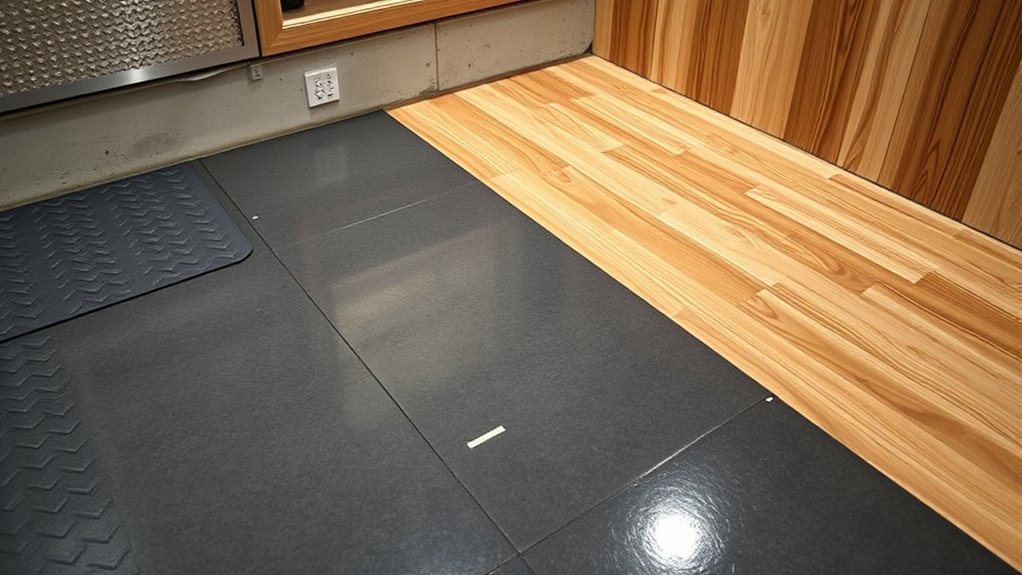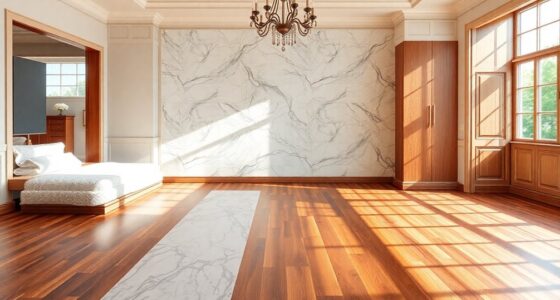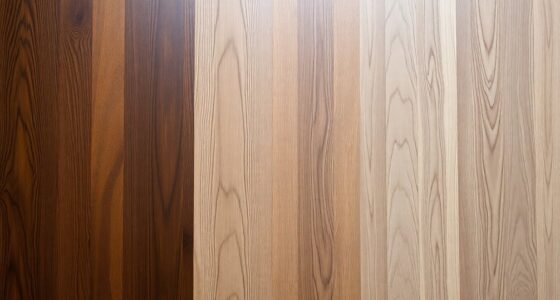To make your basement functional in damp spaces, choose flooring materials like tile or stone that are waterproof and good conductors of heat, especially if you use radiant heating. Always install a proper moisture barrier beneath the floor to prevent water vapor from seeping through your concrete slab, protecting your investment. Proper subfloor preparation and professional guidance ensure long-lasting, mold-free comfort. If you want to learn more about creating a durable, cozy basement, keep exploring your options.
Key Takeaways
- Use moisture barriers like polyethylene sheeting or vapor retarders beneath the flooring to prevent water vapor seepage.
- Opt for tile or natural stone flooring, which conduct heat well and resist moisture better than carpet or laminate.
- Ensure proper subfloor preparation and professional installation to maintain the effectiveness of moisture barriers and flooring.
- Consider radiant heating-compatible materials to add warmth and energy efficiency in damp, cold basement environments.
- Assess local conditions and consult experts for tailored solutions that prevent mold, mildew, and long-term moisture issues.

Are you wondering how to choose the best flooring for your basement? When dealing with damp spaces, it’s vital to select materials that can stand up to moisture and humidity. One of your first considerations should be moisture barriers. These are essential because they prevent water vapor from seeping through the concrete slab and damaging your flooring. Installing a high-quality vapor barrier underneath your chosen flooring helps keep moisture away, reducing the risk of mold, mildew, and wood rot. If your basement tends to be particularly damp, investing in a good moisture barrier is a smart move that can extend the life of your flooring and improve indoor air quality.
Another factor to keep in mind is radiant heat. If you want to add comfort and energy efficiency to your basement, consider flooring options that can accommodate radiant heat systems. Radiant heat involves installing heating cables or panels beneath the flooring, providing warm, even heat that makes your space more livable during colder months. Not all flooring types work well with radiant heat, so you’ll want to choose materials that can transfer heat effectively without warping or cracking. Tile and stone are excellent conductors of heat and can be installed over radiant heating systems with minimal issues, making them ideal choices for chilly basements. Carpet and laminate, on the other hand, may not be suitable if you plan to incorporate radiant heat because they insulate and can hinder heat transfer. Selecting the right flooring in tandem with radiant heat can make your basement cozy and energy-efficient, especially in colder climates. Additionally, understanding the history of pinball machines reveals how technological advancements and popular culture have influenced entertainment options, much like how choosing the right flooring impacts the comfort and durability of your space.
When you’re considering your options, remember that moisture barriers and radiant heat compatibility go hand in hand. By properly installing a vapor barrier during your flooring setup, you protect your investment from moisture-related problems, ensuring your basement remains dry and healthy. It’s also important to assess your climate and local conditions to choose the most suitable flooring and heating solutions. Choosing flooring materials that work with radiant heat can add long-term comfort and efficiency to your space. It’s worth consulting with professionals to ensure your subfloor is prepared correctly, especially if you plan to add radiant heating. With the right combination of moisture barriers and suitable flooring, your basement can become a warm, inviting area that’s resistant to dampness and ready for whatever finishing touches you want to add.
Frequently Asked Questions
How Do I Prevent Mold Growth on Basement Flooring?
To prevent mold growth on basement flooring, you need to focus on moisture control. Use mold-resistant materials like vinyl or sealed concrete to reduce mold risk. Improve ventilation strategies by installing exhaust fans or dehumidifiers to keep humidity levels low. Regularly check for leaks or water intrusion, and clean the area with mold-inhibiting solutions. These steps help maintain a dry, mold-free environment, protecting your basement’s flooring and overall health.
Which Flooring Options Are Most Cost-Effective for Damp Basements?
Imagine you’re back in a time when coal was king—now, choosing budget-friendly options for damp basements is just as vital. You should look for moisture-resistant materials like vinyl, laminate, or painted concrete, which protect your space without breaking the bank. These options are cost-effective and durable, helping you keep moisture out while staying within your budget. With the right choices, your basement stays dry and inviting, all without overspending.
Can I Install New Flooring Over Existing Concrete?
You can install new flooring over existing concrete, but you need to prepare properly. Start by applying a moisture barrier to prevent dampness from seeping through. Use appropriate adhesive solutions if you’re installing tiles or vinyl to ensure a secure bond and added moisture protection. Make sure the existing concrete is clean and level to avoid issues later. This approach helps your new flooring last longer, even in damp conditions.
How Long Does Basement Flooring Typically Last?
Imagine your basement as a sturdy fortress, guarding your home’s foundation. The lifespan of your flooring depends on how well you maintain it and protect it from moisture. With proper moisture barriers and regular flooring maintenance, your basement flooring can last 15-30 years. Neglecting these steps invites dampness and early wear. So, invest in quality materials and upkeep to keep your fortress strong and lasting.
Are There Eco-Friendly Flooring Choices Suitable for Basements?
You can choose eco-friendly flooring options for your basement by focusing on sustainable options that incorporate recycling materials. Bamboo and cork are excellent choices, as they’re renewable and naturally resistant to moisture. Recycled rubber and reclaimed wood also work well, providing durability and eco-conscious benefits. These sustainable options help reduce environmental impact while maintaining a functional, damp-space-friendly basement. Always guarantee proper sealing to prevent moisture issues regardless of your eco-friendly choice.
Conclusion
Choosing the right basement flooring can truly transform your space into a cozy, functional haven. By selecting options that gently handle moisture and dampness, you’ll create an environment that’s both inviting and durable. Remember, a well-considered foundation sets the tone for your entire basement. With the right approach, you can enjoy your basement’s potential without worry—turning it into a welcoming retreat that feels just right.









